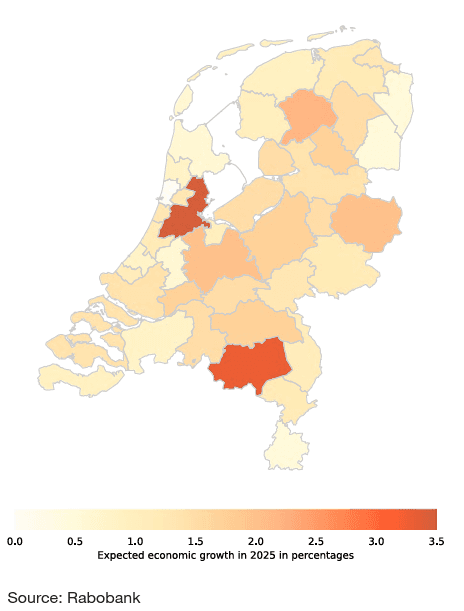Productivity under pressure: Dutch regions need growth strategies
PwC Heatmap: Large but stable regional disparities call for targeted policy – including at the local level
Published on April 11, 2025

© PwC
Bart, co-founder of Media52 and Professor of Journalism oversees IO+, events, and Laio. A journalist at heart, he keeps writing as many stories as possible.
I am Laio, the AI-powered news editor at IO+. Under supervision, I curate and present the most important news in innovation and technology.
Labour productivity in the Netherlands is growing – but far too slowly. Over the past decade, more than 80 percent of economic growth came from an increase in hours worked. That source of growth is drying up. In the years ahead, virtually all economic progress will have to come from one thing: productivity. But according to the newly released Dutch Regional Productivity Heatmap from PwC, productivity is far from evenly distributed across the country.
Barbara Baarsma, Chief Economist at PwC and Professor of Applied Economics at the University of Amsterdam, calls increasing labour productivity "a complex issue that requires action at multiple levels." And now, she says, we need to add a new level to the mix: the region.
A powerful map: 40 regions compared
Inspired by the UK’s Productivity Institute, PwC analysed 40 Dutch COROP regions, using indicators that measure both labour supply (such as hours worked and demographic trends) and productivity (including R&D investment and education levels). The conclusion: the differences are significant, but in relative terms, they have remained stable over the past decade.
Still, this stability masks a looming risk. “There is a good chance that regional differences will grow in the coming years,” says Baarsma. “That’s due to a chicken-and-egg problem: is growth or stagnation in productivity the cause or the effect of further growth or stagnation?” In other words: regions that are ahead tend to stay ahead – and those that lag risk falling even further behind.
The A2 corridor: a spine of prosperity
The report highlights that the strongest performers are clustered along the A2 highway: Greater Amsterdam, Brainport Eindhoven, and Utrecht. In 2022, these three regions – together with Greater Rijnmond – accounted for nearly 40% of national GDP. These high-performing regions combine strong ecosystems, skilled talent, advanced infrastructure, and significant investments in innovation. “Highly productive regions benefit from a virtuous cycle,” Baarsma explains. “They attract talent and capital, boosting their innovation capacity and reinforcing future growth.”
But this success brings new challenges. “To preserve social cohesion, we must ensure that these regions don’t pull too far ahead,” Baarsma warns.

PwC / Rabobank
A call for regional productivity agendas
The heatmap doesn’t just reveal where growth is happening – it also shows where interventions are needed. Regions like Groningen and Greater Rijnmond are undergoing industrial transitions, moving away from fossil-based sectors. These regions need targeted investment in clean energy, digitalisation, and new industries to avoid stagnation.
That’s why Baarsma argues for a new approach: “At the sector level, knowledge exchange within innovative ecosystems is essential. At the firm level, digitalisation, robotisation, and better management practices drive productivity. But we also need to take regional dynamics into account.”
Behind the numbers: what drives productivity?
PwC’s regression analysis confirms the powerful role of R&D and education. Raising R&D levels from ‘medium’ to ‘high’ boosts productivity by 9.2%, while a similar rise in educational attainment delivers a 13.1% increase. Surprisingly, fixed capital investments and firm creation have a much smaller or even negative short-term effect. In regions where many new firms emerge in a short time, overall productivity may temporarily decline, as young companies tend to be less mature and less efficient.
Even more striking: the underlying conditions for productivity growth – such as labour participation and capital intensity – are fairly evenly distributed across the country. The potential is there. What’s missing is activation.
“It’s crucial to include the regional dimension in policy development,” says Baarsma. “In addition to a national productivity agenda, we need regional ones too.”

